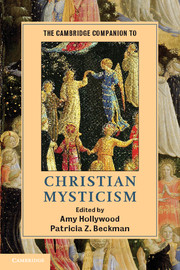Book contents
- Frontmatter
- Contents
- Contributors
- Introduction
- Part I Contexts
- Part II Key Terms
- 5 Apophatic and Cataphatic Theology
- 6 Lectio Divina
- 7 Meditatio/Meditation
- 8 Oratio/Prayer
- 9 Visio/Vision
- 10 Raptus/Rapture
- 11 Unio Mystica/Mystical Union
- 12 Actio et Contemplatio/Action and Contemplation
- Part III Contemporary Questions
- Select Bibliography of Christian Mystical Texts up to around 1750
- Select Bibliography of Modern Works Related to the Study of Western Christian Mysticism
- Author and Artist Index
- General Index
- References
12 - Actio et Contemplatio/Action and Contemplation
from Part II - Key Terms
Published online by Cambridge University Press: 05 December 2012
- Frontmatter
- Contents
- Contributors
- Introduction
- Part I Contexts
- Part II Key Terms
- 5 Apophatic and Cataphatic Theology
- 6 Lectio Divina
- 7 Meditatio/Meditation
- 8 Oratio/Prayer
- 9 Visio/Vision
- 10 Raptus/Rapture
- 11 Unio Mystica/Mystical Union
- 12 Actio et Contemplatio/Action and Contemplation
- Part III Contemporary Questions
- Select Bibliography of Christian Mystical Texts up to around 1750
- Select Bibliography of Modern Works Related to the Study of Western Christian Mysticism
- Author and Artist Index
- General Index
- References
Summary
For most Christian mystics, the experience of the presence of God not only alters their interior journey but also radically transforms their exterior life. Leonardo Boff outlines a new vision for sanctity and mystical union with God that entails being contemplative while working toward liberation. This call to be contemplativus in liberatione, echoing Jerónimo Nadal’s characterization of Ignatius of Loyola’s spirituality as simul in actione contemplativus (“contemplative while in action”), involves a critique of reductive configurations of the relationship between ora et labora (“pray and work”) that devolve into polarizations or spiritual monophysitisms (traditionally the term monophysitism refers to the “heretical” belief that Christ has only one [Greek monos] nature [Greek physis], as his humanity is absorbed and transfigured by his divinity; in this particular context, it signifies a one-sided emphasis on either action or contemplation). For Boff, the summons to be contemplatives in liberation expresses a synthesis of prayer in action that holds the two poles together dialectically, “treating them as two spaces that are open to one another and imply each other.” Boff’s discussion highlights tensions that Christian mystics have wrestled with as they have articulated the relationship between actio and contemplatio. Yet the assertion that a dichotomy between action and contemplation is characteristic of the Christian mystical traditions (mirroring a putative dichotomy between body and soul, world and church) is controverted by an examination of several seminal Christian thinkers.
- Type
- Chapter
- Information
- The Cambridge Companion to Christian Mysticism , pp. 211 - 222Publisher: Cambridge University PressPrint publication year: 2012
References
- 3
- Cited by

